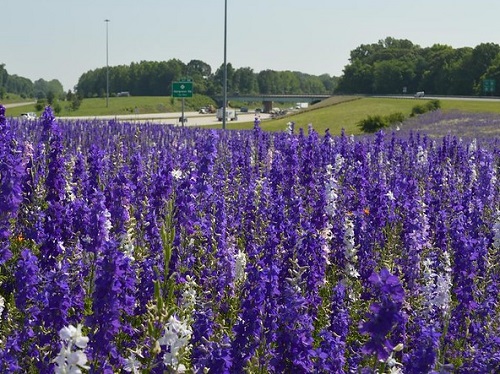Each year, awards sponsored by The Garden Club of North Carolina are given to the best-looking flower beds along highways in every region of the state – awards that recognize the efforts of North Carolina Department of Transportation staff who carry out the agency’s wildflower program, which for 37 years has enhanced the overall appearance and environmental quality of North Carolina’s highways.
[Above photo by NCDOT]
The 2022 Wildflower Awards were presented to NCDOT teams during the April Board of Transportation meeting by NCDOT Roadside Environmental Engineer David Harris. And a Flickr album with photos of the winners is available here.
“Our wildflower beds wouldn’t be successful without the hard work put in by our staff. Their commitment to creating detailed flower beds for everyone to enjoy deserves every recognition,” he explained in a statement. “The Wildflower Program is a long-lasting initiative, and we can’t wait to see the beautiful blooms that are due to grow in 2023.”
State DOTs across the country are not only involved in a variety of wildflower- and pollinator-support efforts, many also use special teams to help preserve native animals and plants during infrastructure projects, which also in some cases using natural vegetation to aid in safety projects, such as the construction of snow fences.
On the pollination side, in October 2021 the Georgia Department of Transportation and the Georgia Association of Conservation Districts or GACD began installing 15 pollinator habitat sites in designated locations as part of a joint effort to educate state residents about the important role “pollinators” such as bees, butterflies, and other insects play in Georgia’s agricultural sector.
“This partnership provides Georgia DOT with the unique opportunity to create a safe and beautiful place for families and travelers to get up close and personal with the wildflowers and grasses [to] learn about how they impact the world around us,” explained Felicity Davis, a landscape architect manager with the Georgia DOT.
“We carefully considered the locations for these gardens and with pedestrian safety in mind, we determined the best option would be at rest areas and Welcome Centers across the state,” she said.
Meanwhile, in March 2022, the Minnesota Department of Transportation began “rejuvenating” seven so-called “living snow fences” in southwest Minnesota as part of a month-long effort to ensure the 20-year-old plantings can survive for another two decades. The agency noted that a “living snow fence” is comprised of trees, shrubs, native grasses, and/or wildflowers to trap snow as it blows across fields, piling it up before it reaches a bridge or roadway.
“A living snow fence is more than landscaping and highway beautification, it serves a purpose,” explained Dan Gullickson, Minnesota DOT’s blowing snow control shared services program supervisor. “We use nature to control blowing snow and rejuvenating these living snow fence sites will safeguard the health and vitality of the plantings.”
Where native plant preservation is concerned, the Arizona Department of Transportation uses “biomonitor” teams from Northern Arizona University or NAU to help the agency’s work crews find and relocate endangered species – including snakes, birds and fish – from construction sites.
Specifically, the biomonitor teams train construction workers and other involved in transportation projects to identify any endangered species and what to do if they come across one. The teams also monitor construction activity and help safely remove any endangered species out of harm’s way.

